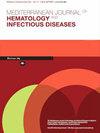CD146 Molecule Expression in B Cells Acute Lymphoblastic Leukemia (B-ALLs): A Flow-Cytometric Marker for an Accurate Diagnostic Workup.
IF 1.5
4区 医学
Q3 HEMATOLOGY
Mediterranean Journal of Hematology and Infectious Diseases
Pub Date : 2024-09-01
DOI:10.4084/mjhid.2024.064
引用次数: 0
Abstract
Background B-lineage acute lymphoblastic leukemias (B-ALL) harboring the t(9;22)(q34;q11)/BCR::ABL1 rearrangement represent a category with previously dismal prognosis whose management and outcome dramatically changed thanks to the use of tyrosine kinase inhibitors (TKIs) usage and more recently full chemo-free approaches. The prompt identification of these cases represents an important clinical need. Objectives We sought to identify an optimized cytofluorimetric diagnostic panel to predict the presence of Philadelphia chromosome (Ph) in B-ALL cases by the introduction of CD146 in our multiparametric flow cytometry (MFC) panels. Methods We prospectively evaluated a total of 245 cases of newly diagnosed B-ALLs with a CD146 positivity threshold >10% referred to the Division of Hematology of 'Sapienza' University of Rome. We compared the results of CD146 expression percentage and its mean fluorescence intensity (MFI) between Ph+ ALLs, Ph-like ALLs, and molecularly negative ALLs. Results Seventy-nine of the 245 B-ALL cases (32%) did not present mutations at molecular testing, with 144/245 (59%) resulting in Ph+ ALL and 19/245 (8%) Ph-like ALLs. Comparing the 3 groups, we found that Ph+ B-ALLs were characterized by higher expression percentage of myeloid markers such as CD13, CD33, and CD66c and low expression of CD38; Ph+ B-ALL showed a higher CD146 expression percentage and MFI when compared with both molecular negative B-ALL and Ph-like ALLs; neither the mean percentage of CD146 expression neither CD146 MFI were statically different between molecular negative B-ALL and Ph-like ALLs. Conclusions Our data demonstrate the association between CD146 expression and Ph+ ALLs. CD146, along with myeloid markers, may help to identify a distinctive immunophenotypic pattern, useful for rapid identification in the diagnostic routine of this subtype of B-ALLs that benefits from a specific therapeutic approach.CD146分子在B细胞急性淋巴细胞白血病(B-ALLs)中的表达:用于准确诊断工作的流式细胞标记。
背景携带t(9;22)(q34;q11)/BCR::ABL1重排的B系急性淋巴细胞白血病(B-ALL)以前预后很差,由于酪氨酸激酶抑制剂(TKIs)的使用以及最近的完全无化疗方法,其管理和预后发生了巨大变化。我们试图通过在我们的多参数流式细胞术(MFC)面板中引入 CD146 来确定一种优化的细胞荧光诊断面板,以预测 B-ALL 病例中是否存在费城染色体(Ph)。方法 我们对转诊至罗马萨皮恩扎大学血液学部的 245 例 CD146 阳性阈值大于 10% 的新诊断 B-ALL 病例进行了前瞻性评估。结果245例B-ALL病例中有79例(32%)在分子检测中未出现突变,其中144/245例(59%)为Ph+ ALL,19/245例(8%)为Ph-like ALL。比较这3组ALL,我们发现Ph+ B-ALL的特点是CD13、CD33和CD66c等髓系标志物的表达率较高,而CD38的表达率较低;与分子检测阴性的B-ALL和Ph样ALL相比,Ph+ B-ALL的CD146表达率和MFI均较高;分子检测阴性的B-ALL和Ph样ALL的CD146平均表达率和CD146 MFI均无统计学差异。我们的数据表明 CD146 表达与 Ph+ ALLs 之间存在关联。CD146 与髓细胞标志物一起,可能有助于确定一种独特的免疫表型模式,从而有助于在常规诊断中快速识别这一亚型 B-ALLs,并从特定的治疗方法中获益。
本文章由计算机程序翻译,如有差异,请以英文原文为准。
求助全文
约1分钟内获得全文
求助全文
来源期刊

Mediterranean Journal of Hematology and Infectious Diseases
Medicine-Hematology
CiteScore
4.20
自引率
6.20%
发文量
113
审稿时长
12 weeks
期刊介绍:
Reciprocal interdependence between infectious and hematologic diseases (malignant and non-malignant) is well known. This relationship is particularly evident in Mediterranean countries. Parasitosis as Malaria, Leishmaniosis, B Hookworms, Teniasis, very common in the southeast Mediterranean area, infect about a billion people and manifest prevalently with anemia so that they are usually diagnosed mostly by experienced hematologist on blood or bone marrow smear. On the other hand, infections are also a significant problem in patients affected by hematological malignancies. The blood is the primary vector of HIV infection, which otherwise manifest with symptoms related to a reduction in T lymphocytes. In turn, infections can favor the insurgency of hematological malignancies. The causative relationship between Epstein-Barr virus infection, Helicobacter pylori, hepatitis C virus, HIV and lymphoproliferative diseases is well known.
 求助内容:
求助内容: 应助结果提醒方式:
应助结果提醒方式:


